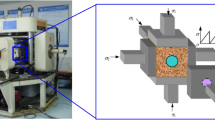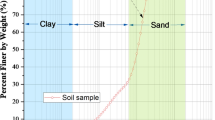Abstract
The ultrasonic pulse velocity (UPV) method can be conveniently used for non-destructive testing of physical–mechanical properties of the stones within historical masonry, as well as to check the state of damage and microcracking. Before to proceed with in situ measurements, it is important to assess the contribution that both intrinsic characteristics of the stones and external factors may give to the ultrasonic response. In this work the effect of different wave frequencies, sample geometry and application of a compression load on the response of a natural stone to UPV test has been investigated. An extensive experimental campaign in laboratory conditions was carried out on a soft limestone, used in the historical building heritage of the Southern Italy. A negligible UPV dispersion was found at the used frequencies of 1 MHz, 120 and 55 kHz when a compression load was not applied; the measured velocities were found to be influenced by the stone inhomogeneity rather than by the sample size. They showed a slight decrease and still negligible dispersion under load up to the visible damage. Dispersion increased with the cracking progression. This indicates that enhanced capability of UPV, in checking material quality and damage conditions, can be obtained by combining the use of different wave frequencies.







Similar content being viewed by others
References
Binda L, Saisi A, Tiraboschi C (2000) Investigation procedures for the diagnosis of historic masonries. Constr Build Mater 14:199–233
Meola C, Di Maio R, Roberti N, Carlomagno GM (2005) Application of infrared thermography and geophysical methods for defect detection in architectural structures. Eng Fail Anal 12:875–892
Carpinteri A, Lacidogna G (2007) Damage evaluation of three masonry towers by acoustic emission. Eng Struct 29:1569–1579
Bosiljkova V, Uranjekb M, Zarnic R, Bokan-Bosiljkov V (2010) An integrated diagnostic approach for the assessment of historic masonry structures. J Cult Herit 11:239–249
Padura AB, Sevilla JB, Navarro JG (2011) Bearing capacity diagnosis of Santiago church (Jerez de la Frontera, Spain). Constr Build Mater 25:2519–2527
Faella G, Frunzio G, Guadagnuolo M et al (2012) The church of the nativity in Bethlehem: non-destructive tests for the structural knowledge. J Cult Herit 13:27–41
Antonaci P, Formia A, Gliozzi AS, Scalerandi M (2013) Diagnostic application of non- linear ultrasonics to characterize degradation by expansive salts in masonry systems. NDT & E Int 55:57–63
Kahraman S (2001) Evaluation of simple methods for assessing the uniaxial compressive strength of rock. Int J Rock Mech Min Sci 38:981–994
Grinzato E, Marinetti S, Bison PG et al (2004) Comparison of ultrasonic velocity and IR thermography for the characterization of stones. Infrared Phys Technol 46:63–68. doi:10.1016/j.infrared.2004.03.009
Yasar E, Erdogan Y (2004) Correlating sound velocity with the density, compressive strength and Young’s modulus of carbonate rocks. Int J Rock Mech Min Sci 41:871–875
Kahraman S (2007) The correlations between the saturated and dry P-wave velocity of rocks. Ultrasonics 46:341–348. doi:10.1016/j.ultras.2007.05.003
Cobanoglu I, Celik SB (2008) Estimation of uniaxial compressive strength from point load strength, Schmidt hardness and P-wave velocity. Bull Eng Geol Environ 67:491–498. doi:10.1007/s10064-008-0158-x
Vasconcelos G, Lourenço PB, Alves CAS, Pamplona J (2008) Ultrasonic evaluation of the physical and mechanical properties of granites. Ultrasonics 48:453–466
Aliabdo AAE, Elmoaty AEMA (2012) Reliability of using non-destructive tests to estimate compressive strength of building stones and bricks. Alex Eng J 51:193–203. doi:10.1016/j.aej.2012.05.004
Ludovico-Marques M, Chastre C, Vasconcelos G (2012) Modelling the compressive mechanical behavior of granite and sandstone historical building stones. Constr Build Mater 28:372–381. doi:10.1016/j.conbuildmat.2011.08.083
Calia A, Mecchi A., Luprano V. et al (1999) Micro-seismic tests in the analysis and characterization of high porosity stone materials. In: Proceedings of 6th international conference on non-destructive testing and microanalysis for the diagnostics and conservation of the cultural and environmental heritage. Rome, Italy,
Mincarone P, Montagna G, Rota P, et al (1999) Impact and ultrasonic tests to investigate the process and the effectiveness of repair for masonry walls. In: Proceedings of 6th international conference on non-destructive testing and microanalysis for the diagnostics and conservation of the cultural and environmental heritage. Rome Italy,
Vasanelli E, Colangiuli D, Calia A et al (2015) Ultrasonic pulse velocity for the evaluation of physical and mechanical properties of a highly porous building limestone. Ultrasonics 60:33–40. doi:10.1016/j.ultras.2015.02.010
UNI EN 14579 (2005) Natural stone test methods—Determination of sound speed propagation
ASTM D2845-08 (2008) Standard test method for laboratory determination of pulse velocities and ultrasonic elastic constants of rock
Shah SP, Chandra S (1970) Mechanical behavior of concrete examined by ultrasonic measurements. J Mater 5:550–563
Popovics S, Rose JL, Popovics JS (1990) The behavior of ultrasonic pulse in concrete. Cem Concr Res 20:259–270. doi:10.1016/0008-8846(90)90079-D
Landis EN, Shah SP (1995) Frequency-dependent stress wave attenuation in cement-based materials. J Eng Mech 121:737–743. doi:10.1061/(ASCE)0733-9399(1995)121:6(737)
Philippidis TP, Aggelis DG (2005) Experimental study of wave dispersion and attenuation in concrete. Ultrasonics 43:584–595. doi:10.1016/j.ultras.2004.12.001
Shiotani T, Aggelis DG (2009) Wave propagation in cementitious material containing artificial distributed damage. Mater Struct 42:377–384. doi:10.1617/s11527-008-9388-4
Aggelis DG (2013) Wave propagation through engineering materials; assessment and monitoring of structures through non-destructive techniques. Mater Struct 46:519–532. doi:10.1617/s11527-013-0020-x
El Azhari H, El Amrani El, El Hassani IE (2013) Effect of the number and orientation of fractures on the P-wave velocity diminution: application on the building stones of the Rabat Area (Morocco). Geomaterials 3:71–81. doi:10.4236/gm.2013.33010
Shah A, Ribakov Y, Zhang Ch (2013) Efficiency and sensitivity of linear and non-linear ultrasonics to identifying micro and macro-scale defects in concrete. Mater Des 50:905–916. doi:10.1016/j.matdes.2013.03.079
Berthaud Y (1991) Damage measurements in concrete via an ultrasonic technique. Part I Experiment. Cem Concr Res 21:73–82. doi:10.1016/0008-8846(91)90033-E
Popovics S, Popovics JS (1991) Effect of stresses on the ultrasonic pulse velocity in concrete. Mater Struct 24:15–23
Prassianakis IN, Prassianakis NI (2004) Ultrasonic testing of non-metallic materials: concrete and marble. Theor Appl Fract Mech 42:191–198. doi:10.1016/j.tafmec.2004.08.007
Lillamand I, Chaix JF, Ploix MA, Garnier V (2010) Acoustoelastic effect in concrete material under uni-axial compressive loading. NDT & E Int 43:655–660. doi:10.1016/j.ndteint.2010.07.001
Suaris W, Fernando V (1987) Detection of crack growth in concrete from ultrasonic intensity measurements. Mater Struct 20:214–220
Quasrawi HY, Marie IA (2003) The use of USPV to anticipate failure in concrete under compression. Cem Concr Res 33:2017–2021. doi:10.1016/S0008-8846(03)00218-7
Antonaci P, Bruno CLE, Gliozzi AS, Scalerandi M (2010) Monitoring evolution of compressive damage in concrete with linear and nonlinear ultrasonic methods. Cem Concr Res 40:1106–1113
Scott TE, Ma Q, Roegiers JC (1993) Acoustic velocity changes during shear enhanced compaction of sandstone. Int J Rock Mech Min Sci Geomech Abstr 30:763–769
Ayling MR, Meredith PG, Murrel SAF (1995) Microcracking during triaxial deformation of porous rocks monitored by changes in rock physical properties, I. Elastic-wave propagation measurements on dry rocks. Tectonophysics 245:205–221
Shubnel A, Nishizawa O, Masuda K et al (2003) Velocity measurements and crack density determination during wet triaxial experiments on Oshima and Toki granites. Pure Appl Geophys 160:869–887
Stanchits S, Vinciguerra S, Dresen G (2006) Ultrasonic velocities, acoustic emission characteristics and crack damage of basalt and granite. Pure Appl Geophys 163:974–993. doi:10.1007/s00024-006-0059-5
Petružálek M., Vilhelm J., Lokajíček T., Rudajev V. (2008) Changes of anisotropy of p-wave velocity propagation during deformation process of rock samples. In: Proceedings of 28-European Conferance on Acustic emission Testing. Krakow, pp 130–135
Blake OO, Faulkner DR, Rietbrock A (2013) The effect of varying damage history in crystalline rocks on the P- and S-wave velocity under hydrostatic confining pressure. Pure Appl Geophys 170:493–505. doi:10.1007/s00024-012-0550-0
Stroisz M, Fjær E (2013) Tracing causes for stress sensitivity of elastic wave velocities in dry Castlegate sandstone. Geophys J Int 192:137–147. doi:10.1093/gji/ggs029
Chen J, Xu Z, Yu Y, Yao Y (2014) Experimental characterization of granite damage using nonlinear ultrasonic techniques. NDT &E Int 67:10–16. doi:10.1016/j.ndteint.2014.06.005
Sun Q, Zhu S (2014) Wave velocity and stress/strain in rock brittle failure. Environ Earth Sci 72:861–866. doi:10.1007/s12665-013-3009-4
Calia A, Tabasso ML, Mecchi AM, Quarta G (2013) The study of stone for conservation purposes: Lecce stone (southern Italy). In: Cassar J, Winter MG, Marker BR et al (eds) Stone in historic buildings: characterization and performance. Geological Society, Special Publications, London, p 391
Aggelis DG, Polyzos D, Philippidis TP (2005) Wave dispersion and attenuation in fresh mortar: theoretical predictions vs experimental results. J Mech Phys Solids 53:857–883. doi:10.1016/j.jmps.2004.11.005
Aggelis DG (2011) Damage characterization of inhomogeneous materials: experiments and numerical simulations of wave propagation. Strain 47:525–533
Muller TM, Gurevich B, Lebedev M (2010) Seismic wave attenuation and dispersion resulting from wave-induced flow in porous rocks—A review. Geophysics 75:147–164. doi:10.1190/1.3463417
Ulm FJ, Constantidines G, Heukamp FH (2004) Is concrete a poromechanics materials?—A multiscale investigation of poroelastic properties. Mater Struct 37:43–58
Fan LF, Wong LNY, Ma GW (2013) Experimental investigation and modeling of viscoelastic behavior of concrete. Constr Build Mater 48:814–821. doi:10.1016/j.conbuildmat.2013.07.010
Murai Y (2007) Scattering attenuation, dispersion and reflection of SH waves in two-dimensional elastic media with densely distributed cracks. Geophys J Int 168:211–223. doi:10.1111/j.1365-246X.2006.03149.x
Chaix JF, Rossat M, Garnier V, Corneloup G (2012) An experimental evaluation of two effective medium theories for ultrasonic wave propagation in concrete. J Acoust Soc Am 131:4481–4490. doi:10.1121/1.4712022
Acknowledgments
This research was carried out in the frame of the A.I.Te.C.H. (Applied Innovation Technologies for Diagnosis and Conservation of Built Heritage) Network of research laboratories and PRO.ME.TE.O.S. (Advanced Products, Methodologies and Technologies for the Diagnosis and Conservation of Historical Built Heritage) Project and supported by Puglia P.O. 2007–2013 FESR funds. The authors want to tank DRC (Diagnostic Research Company) Italia and Michele Massaccesi for the valuable support during the experiments and for instrument provision, technical instructions and precious assistance.
Author information
Authors and Affiliations
Corresponding author
Rights and permissions
About this article
Cite this article
Vasanelli, E., Calia, A., Luprano, V. et al. Ultrasonic pulse velocity test for non-destructive investigations of historical masonries: an experimental study of the effect of frequency and applied load on the response of a limestone. Mater Struct 50, 38 (2017). https://doi.org/10.1617/s11527-016-0892-7
Received:
Accepted:
Published:
DOI: https://doi.org/10.1617/s11527-016-0892-7




